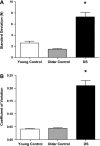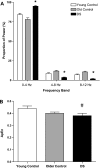Complexity of force output during static exercise in individuals with Down syndrome
- PMID: 19164775
- PMCID: PMC2698634
- DOI: 10.1152/japplphysiol.90555.2008
Complexity of force output during static exercise in individuals with Down syndrome
Abstract
Force variability is greater in individuals with Down syndrome (DS) compared with persons without DS and is similar to that seen with normal aging. The purpose of this study was to examine the structure (in both time and frequency domains) of force output variability in persons with DS to determine whether deficits in force control are similar between individuals with DS and older adults. An isometric handgrip task at a constant force (30% of maximal voluntary contraction) was completed by individuals with DS (n = 29, age 26 yr), and healthy young (n = 26, age 27 yr) and older (n = 33, age 70 yr) individuals. Mean, standard deviation (SD), and coefficient of variation (CV) were used to analyze the magnitude of force output variability. Spectral analysis and approximate entropy (ApEn) were used to analyze the structure of force output variability. Mean force output for DS was lower than in young controls (P < 0.05) but no different from old controls. Individuals with DS had greater SD and CV than young and old controls (P < 0.05). The DS group had a significantly greater proportion of spectral power within the 0-to 4-Hz bandwidth than the young and older controls (P < 0.05). The DS group had significantly lower ApEn values than the young controls (P < 0.05), but there were no differences in ApEn between the DS group and the old controls (P > 0.05). In conclusion, young persons with DS demonstrate enhanced temporal structure and greater amplitude of low-frequency oscillations in the force output signal than age-matched non-DS peers. Interestingly, young persons with DS and older persons without DS have similar time-dependent structure of force output variability. This would suggest a possible link between premature aging and less complex force output in persons with DS.
Figures





References
-
- Almeida GL, Corcos DM, Latash ML. Practice and transfer effects during fast single-joint elbow movements in individuals with Down syndrome. Phys Ther 74: 1000–1012; discussion 1012–1006, 1994. - PubMed
-
- Almeida GL, Marconi NF, Tortoza C, Ferreira SMS, Gottlieb GL, Corcos DM. Sensorimotor deficits in Down syndrome: implications for facilitating motor performance. In: Perceptual-Motor Behavior in Down Syndrome, edited by Weeks DJ, Chua R, Elliott, D. Champaign, IL: Human Kinetics, 2000, p. 151–174.
-
- Andersen BB, Gundersen HJ, Pakkenberg B. Aging of the human cerebellum: a stereological study. J Comp Neurol 466: 356–365, 2003. - PubMed
-
- Angelopoulou N, Matziari C, Tsimaras V, Sakadamis A, Souftas V, Mandroukas K. Bone mineral density and muscle strength in young men with mental retardation (with and without Down syndrome). Calcif Tissue Int 66: 176–180, 2000. - PubMed
-
- Anson JG, Mawston GA. Patterns of muscle activation in simple reaction-time tasks. In: Perceptual-Motor Behavior in Down Syndrome, edited by Weeks DJ, Chua R, Elliot D. Champaign, IL: Human Kinetics, 2000, p. 3–24.
Publication types
MeSH terms
Grants and funding
LinkOut - more resources
Full Text Sources
Medical
Research Materials

